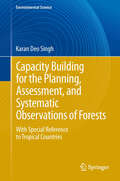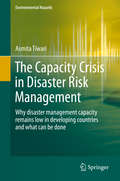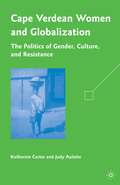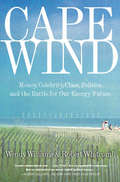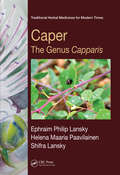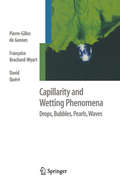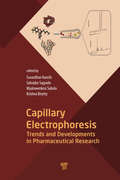- Table View
- List View
Canonical Perturbation Theories: Degenerate Systems and Resonance (Astrophysics and Space Science Library #345)
by Sylvio Ferraz-MelloThe book is written mainly to advanced graduate and post-graduate students following courses in Perturbation Theory and Celestial Mechanics. It is also intended to serve as a guide in research work and is written in a very explicit way: all perturbation theories are given with details allowing its immediate application to real problems. In addition, they are followed by examples showing all steps of their application.
Canonical Problems in the Theory of Plasmonics: From 3D to 2D Systems (Springer Series in Optical Sciences #230)
by Afshin MoradiThis book provides a systemic and self-contained guide to the theoretical description of the fundamental properties of plasmonic waves. The field of plasmonics is built on the interaction of electromagnetic radiation and conduction electrons at metallic interfaces or in metallic nanostructures, and so to describe basic plasmonic behavior, boundary-value problems may be formulated and solved using electromagnetic wave theory based on Maxwell’s equations and the electrostatic approximation.In preparation, the book begins with the basics of electromagnetic and electrostatic theories, along with a review of the local and spatial nonlocal plasma model of an electron gas. This is followed by clear and detailed boundary value analysis of both classical three-dimensional and novel two-dimensional plasmonic systems in a range of different geometries. With only general electromagnetic theory as a prerequisite, this resulting volume will be a useful entry point to plasmonic theory for students, as well as a convenient reference work for researchers who want to see how the underlying models can be analysed rigorously.
Canopy Photosynthesis: From Basics to Applications (Advances in Photosynthesis and Respiration #42)
by Kouki Hikosaka Ülo Niinemets Niels P. R. AntenThe last 30 years has seen the development of increasingly sophisticated models that quantify canopy carbon exchange. These models are now essential parts of larger models for prediction and simulation of crop production, climate change, and regional and global carbon dynamics. There is thus an urgent need for increasing expertise in developing, use and understanding of these models. This in turn calls for an advanced, yet easily accessible textbook that summarizes the “canopy science” and introduces the present and the future scientists to the theoretical background of the current canopy models.This book presents current knowledge of functioning of plant canopies, models and strategies employed to simulate canopy function, and the significance of canopy architecture, physiology and dynamics in ecosystems, landscape and biosphere.
Capacitance Spectroscopy of Semiconductors
by Jian V. Li and Giorgio FerrariCapacitance spectroscopy refers to techniques for characterizing the electrical properties of semiconductor materials, junctions, and interfaces, all from the dependence of device capacitance on frequency, time, temperature, and electric potential. This book includes 15 chapters written by world-recognized, leading experts in the field, academia, national institutions, and industry, divided into four sections: Physics, Instrumentation, Applications, and Emerging Techniques. The first section establishes the fundamental framework relating capacitance and its allied concepts of conductance, admittance, and impedance to the electrical and optical properties of semiconductors. The second section reviews the electronic principles of capacitance measurements used by commercial products, as well as custom apparatus. The third section details the implementation in various scientific fields and industries, such as photovoltaics and electronic and optoelectronic devices. The last section presents the latest advances in capacitance-based electrical characterization aimed at reaching nanometer-scale resolution.
Capacitance Spectroscopy of Semiconductors
by Jian V. Li Giorgio FerrariCapacitance spectroscopy refers to techniques for characterizing the electrical properties of semiconductor materials, junctions, and interfaces, all from the dependence of device capacitance on frequency, time, temperature, and electric potential. This book includes 15 chapters written by world-recognized, leading experts in the field, academia, national institutions, and industry, divided into four sections: Physics, Instrumentation, Applications, and Emerging Techniques. The first section establishes the fundamental framework relating capacitance and its allied concepts of conductance, admittance, and impedance to the electrical and optical properties of semiconductors. The second section reviews the electronic principles of capacitance measurements used by commercial products, as well as custom apparatus. The third section details the implementation in various scientific fields and industries, such as photovoltaics and electronic and optoelectronic devices. The last section presents the latest advances in capacitance-based electrical characterization aimed at reaching nanometer-scale resolution.
Capacitor circuits (contracted)
by RnibShows two circuits with capacitors.The top circuit starts on the left with two horizontal line of different length, which is the standard symbol for a power supply. Moving anti-clockwise around the circuit brings you to a standard capacitor symbol (2 lines with the same lengths), next is a rectangle (a resistor), the a switch (a break in the wire) and then its back to the power supply to complete the circuit. The bottom circuit contains all the same components except for the power supply. On either side of the capacitor there are + and - which shows the charge stored in the capacitor.
The Capacitor Handbook
by Cletus J. KaiserA long and varied experience in many areas of electronic circuit design has convinced me that capacitors are the most misunderstood and misused electronic component. This book provides practical guidance in the understanding, construction, use, and application of capacitors. Theory, combined with circuit application advice, will help to under stand what goes on in each component and in the final design. All chapters are arranged with the theory of the dielectric type discussed first, followed by circuit application information. With all chapters arranged in the same manner, this will make reading and using this book for reference easier. A practical glossary of terms used in the capacitor industry is included. The first chapter covers basic information that applies to all types of capacitors. Each following chapter addresses a different capacitor dielectric. This book could have been titled: 'Everything You Wanted To Know About Capacitors, But Were Afraid To Ask .. .' ix Preface THE CAPACITOR HANDBOOK Chapter 1 Fundamentals For All Capacitors For all practical purposes, consider only the parallel plate capacitor as illustrated in Fig. 1.1-two conductors or electrodes separated by a dielectric material of uniform thickness. The conductors can be any material that will conduct electricity easily. The dielectric must be a poor conductor-an insulator. Conductor (Electrode) Dielectric ,;~;...--~ Conductor (Electrode) 1..-----Wire to Outside World Fig. 1.1 The Parallel-Plate Capacitor Fig. 1.2 illustrates the symbol for a capacitor used in schematic diagrams of electronic circuits. The symbol resembles a parallel-plate model.
Capacitor Symbols (Large Print)
by Rnib BookshareThis page shows IEC (International Electrotechnical Commission) symbols for a capacitor, a polarised capacitor, a variable capacitor, and a trimmer capacitor. There is a locator dot shown, which will be at the top left of the page when the image is the correct way up. The symbols are on the left of the page and the descriptive labels are on the right.
Capacitor Symbols (UEB Contracted)
by Rnib BookshareThis page shows IEC (International Electrotechnical Commission) symbols for a capacitor, a polarised capacitor, a variable capacitor, and a trimmer capacitor. There is a locator dot shown, which will be at the top left of the page when the image is the correct way up. The symbols are on the left of the page and the descriptive labels are on the right.
Capacitor Symbols (UEB Uncontracted)
by Rnib BookshareThis page shows IEC (International Electrotechnical Commission) symbols for a capacitor, a polarised capacitor, a variable capacitor, and a trimmer capacitor. There is a locator dot shown, which will be at the top left of the page when the image is the correct way up. The symbols are on the left of the page and the descriptive labels are on the right.
Capacity Building for the Planning, Assessment and Systematic Observations of Forests: With Special Reference to Tropical Countries (Environmental Science and Engineering)
by Karan Deo SinghThis book is intended to support the forestry institutions in the tropical countries in the planning, assessment and systematic observation of forests required to fulfill their obligations as laid in international conventions such as the CBD and UNFCCC. Following the Rio Conference, a number of countries, donors and international organizations have implemented capacity-building projects with varying degrees of success. One main reason for the varying success rates seems to lie in the design of technical assistance programs, which have been formulated on the traditional lines of mainly generating forest resources information or transferring technology; whereas Agenda 21 requires fundamental changes in countries’ institutions and approaches to planning and implementing the conservation and sustainable development of forests through a process of continuing research and analysis. The book is intended to serve the basic needs of national planning strategies and international and donor support.
Capacity Building in Technology Transfer: The European Experience (SxI - Springer for Innovation / SxI - Springer per l'Innovazione #14)
by Massimiliano Granieri Andrea BassoThis book tells the story of capacity building in Europe with respect to technology transfer offices and organizations (TTOs). The traditional underdevelopment of technology markets in Europe has often been explained in terms of lack of capacity and skills among technology transfer professionals, both as individuals and as part of TTOs. Because of the severe consequences for economic development and industrial growth, this situation has been repeatedly addressed by policy makers, until the European Commission, within the framework of Horizon 2020, decided to initiate a pan-European pilot project on capacity building. This book builds on the experience gained through that project and tries to reconnect it with current scholarly works on technology management by focusing on the new methodology developed. In addition, the authors present a series of case studies that may be used as a benchmark and as examples that will help high-potential TTOs to improve their performance. Both practitioners and researchers will benefit from the holistic perspective of the book, which goes beyond the traditional approach and attempts to reconcile the theory and practice of organizing for technology transfer.
The Capacity Crisis in Disaster Risk Management: Why disaster management capacity remains low in developing countries and what can be done (Environmental Hazards)
by Asmita TiwariHow can a place be built and managed so that it is safe for people to live? Ironically, many governments and citizens keep on asking the same question after every new disaster. Why, even with high levels of investment in increasing government’s capacity to manage disasters, do the impacts of disasters continue to increase? What can the governments do differently? What is the role of local communities? Where should aid agencies invest? This book looks into these critical questions and highlights how current capacity development efforts might be resulting in the opposite—capacity crisis or capability trap. The book provides a new approach for the understanding and the developing of effective local capacity to reduce and manage future disaster impacts.
Cape Verdean Women and Globalization: The Politics of Gender, Culture, and Resistance
by K. Carter J. AuletteThis book employs critical ethnography and critical discourse analysis to explore what Cape Verdeans have to say about women's lives in the era of twenty-first century globalization. The authors investigate the economic and personal difficulties they face such as poverty, managing single mother-headed households, and violence.
Cape Wind: Money, Celebrity, Class, Politics, and the Battle for Our Energy Future on Nantucket Sound
by Wendy Williams Robert WhitcombWhen Jim Gordon set out to build a wind farm off the coast of Cape Cod, he knew some people might object. But there was a lot of merit in creating a privately funded, clean energy source for energy-starved New England, and he felt sure most people would recognize it eventually. Instead, all Hell broke loose. Gordon had unwittingly challenged the privileges of some of America's richest and most politically connected people, and they would fight him tooth and nail, no matter what it cost, and even when it made no sense.Cape Wind is a rollicking tale of democracy in action and plutocracy in the raw as played out among colorful and glamorous characters on one of our country's most historic and renowned pieces of coastline. As steeped in American history and local color as The Prince of Providence; as biting, revealing and fun as Philistines at the Hedgerow, it is also a cautionary tale about how money can hijack democracy while America lags behind the rest of the developed world in adopting clean energy.
Caper: The Genus Capparis (Traditional Herbal Medicines for Modern Times #12)
by Ephraim Philip Lansky Helena Maaria Paavilainen Shifra LanskyCaper: The Genus Capparis presents a pharmacognostic and ethnopharmacological exploration of the genus Capparis, emphasizing its medicinal potential. There is a long history of safe usage of Capparis parts both in diet and as plant drugs throughout the world, and the details of this usage are summarized in 39 tables covering numerous Capparis speci
Capillarity and Wetting Phenomena: Drops, Bubbles, Pearls, Waves
by Pierre-Gilles de Gennes Francoise Brochard-Wyart David QuereThe study of capillarity is in the midst of a veritable explosion. What is offered here is not a comprehensive review of the latest research but rather a compendium of principles designed for the undergraduate student and for readers interested in the physics underlying these phenomena.
Capillary carrying food to cells (large print)
by RnibThis labelled diagram shows a capillary (small blood vessel) carrying food to body tissue. There is a locator dot shown, which will be at the top left of the page when the image is the correct way up. The capillary runs horizontally across the top part of the page with an arrow indicating the direction of blood flow. Down the page are five cells absorbing the nutrients that are leaking out from the capillary. Each cell has a nucleus represented by a large dot.
Capillary carrying food to cells (UEB contracted)
by RnibThis labelled diagram shows a capillary (small blood vessel) carrying food to body tissue. There is a locator dot shown, which will be at the top left of the page when the image is the correct way up. The capillary runs horizontally across the top part of the page with an arrow indicating the direction of blood flow. Down the page are five cells absorbing the nutrients that are leaking out from the capillary. Each cell has a nucleus represented by a large dot.
Capillary carrying food to cells (UEB uncontracted)
by RnibThis labelled diagram shows a capillary (small blood vessel) carrying food to body tissue. There is a locator dot shown, which will be at the top left of the page when the image is the correct way up. The capillary runs horizontally across the top part of the page with an arrow indicating the direction of blood flow. Down the page are five cells absorbing the nutrients that are leaking out from the capillary. Each cell has a nucleus represented by a large dot.
Capillary Electrophoresis: Trends and Developments in Pharmaceutical Research
by Suvardhan Kanchi Salvador Sagrado Myalo I. Sabela Krishna BisettyCapillary electrophoresis (CE) has become an established method with widespread recognition as an analytical technique of choice in numerous analytical laboratories, including industrial and academic sectors. Pharmaceutical and biochemical research and quality control are the most important CE applications. This book provides a comparative assessment of related techniques on mode selection, method development, detection, and quantitative analysis and estimation of pharmacokinetic parameters and broadens the understanding of modern CE applications, developments, and prospects. It introduces the fundamentals of CE and clearly outlines the procedures used to mitigate several barriers, such as detection limits, signal detection, changing capillary environment, resolution separation of analytes, and hyphenation of mass spectrometry with CE, for a range of analytical problems. Each chapter outlines a specific electrophoretic variant with detailed instructions and some standard operating procedures. In this respect, the book meets its desired goal of rendering assistance to lovers of electrophoresis.
Capillary Electrophoresis: Trends and Developments in Pharmaceutical Research
by Suvardhan Kanchi Salvador Sagrado Myalo I. Sabela Krishna BisettyCapillary electrophoresis (CE) has become an established method with widespread recognition as an analytical technique of choice in numerous analytical laboratories, including industrial and academic sectors. Pharmaceutical and biochemical research and quality control are the most important CE applications. This book provides a comparative assessment of related techniques on mode selection, method development, detection, and quantitative analysis and estimation of pharmacokinetic parameters and broadens the understanding of modern CE applications, developments, and prospects. It introduces the fundamentals of CE and clearly outlines the procedures used to mitigate several barriers, such as detection limits, signal detection, changing capillary environment, resolution separation of analytes, and hyphenation of mass spectrometry with CE, for a range of analytical problems. Each chapter outlines a specific electrophoretic variant with detailed instructions and some standard operating procedures. In this respect, the book meets its desired goal of rendering assistance to lovers of electrophoresis.
Capillary Electrophoresis: Methods and Protocols (Methods in Molecular Biology #1483)
by Philippe Schmitt-KopplinThis new edition presents principle methods in capillary electrophoresis (CE) separation involving CZE, MEKC, MECC, NACE, and corresponding hyphenated techniques to organic mass spectrometry and ICP-MS. Recent developments in the techniques of single cell analysis, as well as derivation, enantioseparation or the use of ionic liquids, and the use of CZE for the separation of living cells are also highlighted. This book discusses various application methods for the analysis of small ions, organic acids, amino acids, and (poly)saccharides to peptides that are shown with pollutants and biomarkers in food and health. Written in the highly successful Methods in Molecular Biology series format, chapters include introductions to their respective topics, lists of the necessary materials and reagents, step-by-step, readily reproducible laboratory protocols, and tips on troubleshooting and avoiding known pitfalls.Cutting edge and thorough, Capillary Electrophoresis: Methods and Protocols, Second Edition covers a wide field of interests and will be especially great for beginners and students because of its combined focus on mini-reviews and application notes that will help them quickly get an overview of the field.
Capillary Electrophoresis: Methods and Protocols (Methods in Molecular Biology #384)
by Philippe Schmitt-KopplinThis book presents a selection of current capillary electrophoresis methods used to separate representative types of molecules and particles and in combination with different detection techniques. It includes practical details which are hard to find elsewhere. The volume is intended for beginners in the field and provides an overview of the technique and a starting point for the exploration of the defined literature on different application topics.







